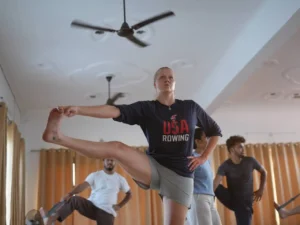The Dolphin Plank Pose is a yoga pose that helps to build strength, improve balance, and calm the mind. It’s a mix of two other poses — the classic Plank Pose and the Dolphin Pose — and is also called Makara Adho Mukha Svanasana in Sanskrit.
Though it might look simple at first, Dolphin Plank is a powerful pose that challenges your whole body. Over time, it can boost your fitness, increase confidence, and help you feel more balanced inside and out.
Let’s explore how to do it, what it’s good for, and how to stay safe while practicing it.
What Is Dolphin Plank Pose?
Dolphin Plank Pose is done on the forearms instead of the hands, which makes it different from the traditional plank pose. It strengthens your core, shoulders, and arms, while also gently stretching parts of your legs and feet.
This pose also has a deeper meaning. It’s said to combine the qualities of two animals:
- The Dolphin: playful, joyful, and intelligent.
- The Crocodile: strong, stable, and tough.
Together, they represent a balance between strength and joy — a reminder that you can be powerful and light-hearted at the same time.
Why Do People Practice Dolphin Plank?
Aside from physical benefits, this pose is believed to activate the solar plexus chakra (called Manipura), which is related to:
- Willpower
- Self-confidence
- Inner strength
When practiced regularly, it can help you feel more grounded, confident, and motivated in everyday life.
How to Do Dolphin Plank Pose: Step-by-Step
1. Start in a Tabletop Position
- Get on your hands and knees.
- Keep your wrists under your shoulders and your knees under your hips.
2. Lower to Your Forearms
- Place your forearms on the floor.
- Your elbows should be right under your shoulders.
- Keep your arms parallel and palms facing down.
3. Step Your Feet Back
- One foot at a time, step back until your body forms a straight line from head to heels — like a plank.
- Make sure your hips don’t sag or lift too high.
4. Engage Your Core
- Tighten your belly muscles to support your lower back.
- Press your forearms into the ground and keep your shoulders active.
5. Relax Your Neck
- Look between your hands or toward your toes.
- Keep your neck in line with your spine — no straining.
6. Hold the Pose
- Stay in this position and breathe deeply.
- Start with 10–15 seconds, and slowly increase over time.
7. Release the Pose
- When ready, gently lower your knees and rest in Child’s Pose to relax.
How Long Should You Hold Dolphin Plank Pose?
It depends on your experience and strength level:
- Beginners: Start with 10–15 seconds. This is enough to begin building strength.
- Intermediate: Work up to 30 seconds to 1 minute.
- Advanced: Some experienced yogis hold it for 2–3 minutes or add movement, like leg lifts or side dips.
No matter your level, always focus on steady breathing and proper form over how long you can hold the pose.
Benefits of Dolphin Plank Pose
💪 1. Strengthens Your Core
Your abs, lower back, and glutes are all working here. A strong core helps with posture and makes other exercises easier.
🧘♂️ 2. Builds Upper Body Strength
This pose works your shoulders, arms, and upper back. With regular practice, you’ll feel stronger and more toned.
🤸♀️ 3. Improves Balance and Focus
Balancing on your forearms and toes requires concentration. This pose helps train your mind to stay focused and calm.
🦵 4. Stretches Your Legs
While holding the plank, your hamstrings (back of your thighs), calves, and even the arches of your feet get a gentle stretch.
🧠 5. Calms the Mind
Because this pose requires stillness and breath control, it helps reduce stress, anxiety, and mental clutter.
🌞 6. Boosts Confidence and Inner Strength
Activating the solar plexus chakra can help increase your self-belief and push through self-doubt.
Safety Tips and Precautions
🚫 1. Be Careful with Shoulder or Neck Injuries
This pose puts pressure on the shoulders. If you’ve had injuries or feel pain in your neck or shoulders, skip this pose or modify it with support.
🐢 2. Go Slow
Don’t rush into holding it for a long time. Build strength gradually. It’s okay to come out of the pose early if you feel tired or shaky.
🔒 3. Engage Your Core
Avoid letting your belly sag or your hips pop up. Keep your body in a straight line to avoid putting pressure on your lower back.
🤰 4. Avoid During Pregnancy
Dolphin plank puts pressure on the belly and can be uncomfortable or unsafe during pregnancy. Talk to a doctor or prenatal yoga instructor before trying it.
🧏 5. Always Listen to Your Body
Yoga is not about pushing through pain. If something doesn’t feel right, come out of the pose and rest. You can always try again later.
Tips for Beginners
- Use a yoga block under your chest or thighs for support.
- Practice near a wall if you feel unsteady.
- Don’t hold your breath — breathe deeply and slowly.
- Warm up with a few rounds of Cat-Cow or gentle stretching.
Final Thoughts
Dolphin Plank Pose may look simple, but it’s a powerful part of any yoga practice. It builds strength, increases flexibility, improves focus, and helps you connect with your inner confidence.
Whether you’re brand new to yoga or looking to deepen your practice, adding Dolphin Plank Pose can bring a lot of physical and mental benefits. Just remember to start slow, focus on your breath, and always honor your body’s limits.
Want to learn more poses like this?
Join our upcoming Yoga Teacher Training Course at Jeevatman Yogshala . Explore the wisdom of yoga, deepen your practice, and grow stronger — inside and out.
Let us guide you on your journey toward strength, balance, and inner peace. 🧘♀️✨








